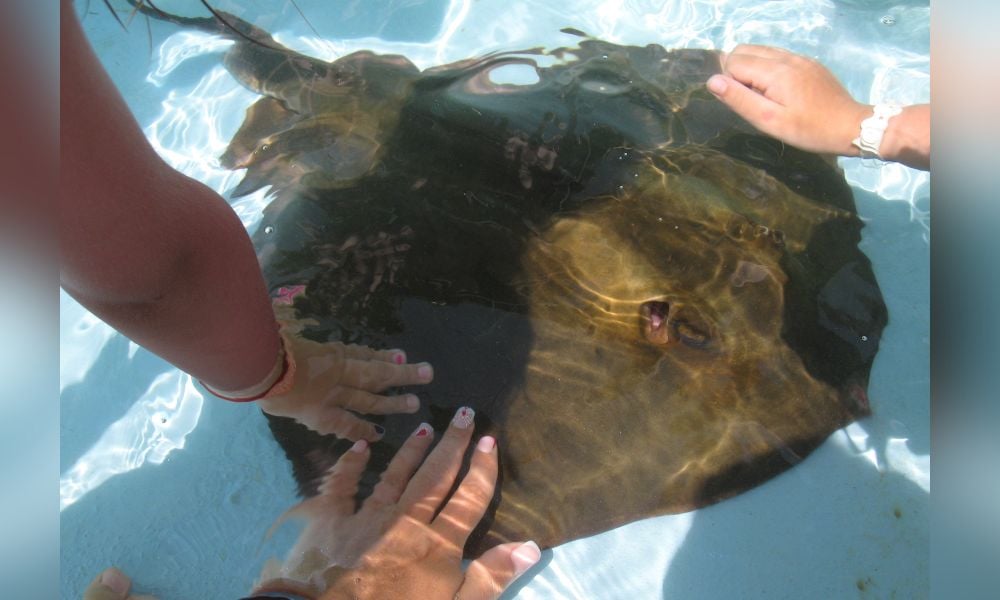Fish and other marine animals, including sensitive stingrays and starfish, are suffering massively in aquariums and “touch tank” exhibits, according to a new report from Born Free USA.
The report tackled several aquariums’ claims that they collected sea animals from their wild homes for “conservation” and “education” — noting several disturbing trends across three renowned aquariums in Illinois, Texas, and Maryland.
In particular, researchers noted reportedly small and unsafe tank sizes and designs, injuries sustained by the captive animals, and stressed animals hiding and swimming away as best they could when visitors approached.
They also observed other stereotypic behavior showing psychological stress in the animals, including pacing — or fish swimming in circles inside their small enclosures — and stingray “surfacing,” a behavior that wouldn’t occur naturally in the wild in which the animals break the surface of the water, sometimes repeatedly in a matter of minutes.

A Ray Surfacing (Born Free USA Investigation)
Investigators also noted a lack of live vegetation in tanks, with animals including seahorses given only plastic plants and fake corals — elements that may make tanks appear “pretty” for visitors but that don’t actually do anything for the well-being of their inhabitants.
Disturbingly, there are no nationwide standards for touch tanks, or interactive exhibits that feature open-topped enclosures from which people can pet captive animals with nowhere to go — typically horseshoe crabs, stingrays, starfish, or anemones. Aquariums therefore have broad discretion over which species to include, how frequently the animals are handled, and what measures they’ll take to reduce stress, injury, and disease to the animals by visitors.
Born Free’s investigators noted minimal — if any — education about the animals in the touch tanks they visited.
At one, employees asked children to wash their hands before touching animals, but the exhibit had no educational signs about the animals in the tank, including even their common names, according to Born Free USA.
At another, signs indicated that stingrays are delicate animals but still encouraged people to touch them.
At a third aquarium, employees encouraged people to touch vulnerable moon jellyfish, whose bottom tentacles can be easily damaged by contact with human skin. Born Free noted no signage about the harm touching the jellyfish from the bottom could do and reported the employees gave only scattered warnings about this to people touching the jellyfish.

(Courtesy of Born Free USA)
Globally, about 1 billion ornamental fish from 5,400 species are enduring this exploitation each year, according to Born Free. The report also outlines the harmful effects that this massive collecting for private collections has on wild fish populations and emphasizes other studies proving fish sentience — including that they can feel pain and distress.
The investigators’ and researchers’ findings make clear that sentient fish do not belong in tiny glass tanks, said Born Free CEO Angela Grimes.
“Our investigation confirms that, even at the ‘best’ aquariums in the world, the needs of fish are vastly overlooked and, in many cases, completely neglected, often resulting in observable physical and mental suffering,” she said.
She added, “They do not belong in tiny glass tanks devoid of any meaningful environmental elements. They deserve freedom, no matter how much smaller or different they seem compared to the rest of the animal kingdom.”

(Courtesy of Born Free USA)
Born Free recommends that zoos and aquariums immediately halt the cruel capture of wild fish to stock collections and ban touch tanks. Fish also should be included in the definition of “animal” in state and federal animal cruelty legislation, according to the nonprofit.
Lady Freethinker agrees that wild fish do not belong in cruel captivity and deserve the same protections as orcas, dolphins, turtles, or other marine life!
We encourage our readers to never attend any venue that exploits live animals for profit, including aquariums and zoos! There are many fun activities you can do that don’t involve harming animals or contributing to the demand for their cruel capture – check out our list of ideas here, and thank you for helping us make a difference for animals!








